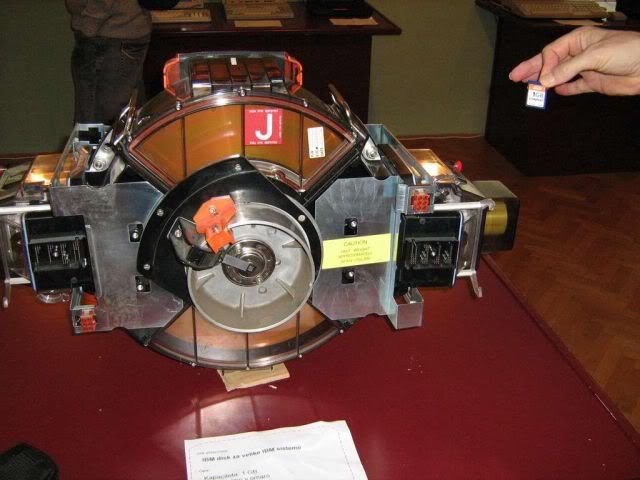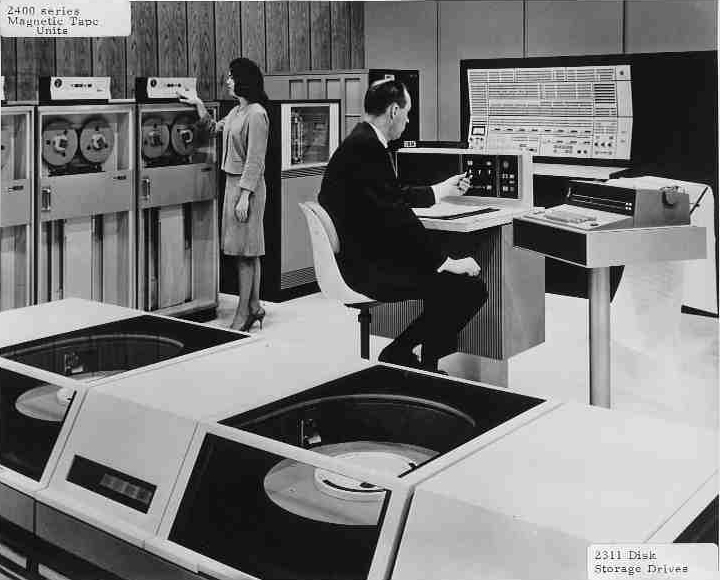
Write tracks on the 125TB tape are overlapped, like shingles on a roof.
Posted on 10/19/2012 1:15:11 PM PDT by Ernest_at_the_Beach
In January 2010, IBM demonstrated a tape with 35TB of raw capacity. Apply LTO-6's 2.5:1 compression ratio to that and you get 87.5TB. This contrasted with the then-current LTO-5 tape's raw capacity of 1.5TB.
The LTO consortium has a roadmap of two more formats: LTO-7 with 6.48TB raw capacity, and LTO-8 with 12.8TB. Assuming that the upcoming LTO format capacity doubling, IBM's 35TB tape, created with the help of Fujifilm, would fit between a conceivable LTO-9 with around $25TB and an LTO-10 with 50TB.
At the time we said such a tape would take three days to fill at LTO-5 speeds. This does not matter as it is restore speed that is vital, and a fast streaming drive would get to the start point of a file needing restoration in seconds.
At the Tape Summit, Paul Scheuer, tape brand management programme director in Big Blue's Storage Systems Division, said IBM was developing a 125TB tape – 3.6 times more capacious than the 35TB tape. It is able to do this because the physical size of a bit on tape is many times larger than the size of a bit on disk, and can be shrunk without having to go to the difficult and expensive bit-patterned media and energy-assisted recording techniques facing disk drive manufacturers in their quest to increase areal density.
A tape read/write head doesn't have to move anything like as much as a disk head, which snakes in and out across a disk platter's surface, hunting for the destination data track and then following it. Scheuer said that a tape read:write head also read from narrower tracks than it wrote, and write tracks were overlapped, shingled like roofing tiles, so more of them could be put down along a tape's surface.

Write tracks on the 125TB tape are overlapped, like shingles on a roof.
By increasing the sensitivity and bit granularity of the read:write heads and shrinking the physical size of the bits, to a 100Gbits/in 2 areal density, a 125TB capacity tape using a development of today's barium ferrite recording media technology, should be attainable. This could theoretically enable an LTO-11 format with 100TB raw capacity and 250TB compressed capacity.
Scheuer pointed out that tape cartridge capacity needed to develop so as to maintain a consistent advantage over 3.5-inch disk drive capacity. We have 4TB disks today and LTO-6 tapes with 6.25TB compressed capacity. As long as successive tape formats sustain the capacity advantage over disk then tape's cost/GB advantages over disk should be sustained as well.
There is a prospect here of the LTFS file:folder tape interface combining with a 100TB or more tape cartridges to provide a highly attractive and dense storage medium for businesses needing access to lots of large files, such as high-definition videos and other large data sets that individuals need to work on. With LTFS and such tape cartridge capacities, the notion that tape could be an individual or small workgroup's backup medium could perhaps be re-evaluated. ®
Store everything ....
First 1gb hard drive next to what replaced it.


They've replaced the 2400 9-track tape drives already? Up to 140MB capacity. Not even a million times more capacity yet.
*****************************EXCERPTS*******************************************
Linear Tape-Open (or LTO) is a magnetic tape data storage technology originally developed in the late 1990s as an open standards alternative to the proprietary magnetic tape formats that were available at the time. Hewlett-Packard, IBM and Seagate initiated the LTO Consortium, which directs development and manages licensing and certification of media and mechanism manufacturers. Seagate's tape division was spun-off as Certance and is now part of Quantum Corp.
The standard form-factor of LTO technology goes by the name Ultrium, the original version of which was released in 2000 and could hold 100 GB of data in a cartridge. A version released in 2010 can hold 1.5 TB in a cartridge of the same size.
Upon introduction, LTO Ultrium rapidly defined the super tape market segment and has consistently been the best-selling super tape format.[1][2] LTO is widely used with small and large computer systems, especially for backup.
I remmeber all of that /,,,,”stuff”.
So uh how many songs will fit on it?
Tape backup has a bad “track record”. It seems like half the time data needs to be restored from tape it can’t be done.
” It seems like half the time data needs to be restored from tape it can’t be done.”
We always made duplex backups ‘just in case’. I also made separate backups of the user volumes which were the ones that got hosed the most by our retard programmers. :)
When I was in business school, we had a huge IBM installation upon which we loaded the software with punch cards
Well 27TB is needed to theoretically backup a human mind, so can we backup our brains now?
Did you miss the "portable 125TB" part?
That study was done on liberals.
Any IT Director using tape to back up mission critical files needs to be fired.
...a... er... gee.... HUH? Wait, What?
Why on earth you you need to carry that much data around with you? Back it up to a VM server with a SAN. Pull down whatever of it you need on demand.
Done.
“Did you miss the “portable 125TB” part? “
If it’s rolling tape it has to do it the way tape drives roll tape, as far as I know. That requires complexity. Tape drives at the height of their use were amazingly complex and reliable. But start, stop, FF, rewind, search beats hell out of the mech as well as grinds down the tape path. I’m abosolutely stunned that they have a present day use.
Inside IBM, as well as in other computer technology firms, this has been a long-running competition between magnetic tape technology and hard disk technology. I can’t remember how many conferences and seminars where one IBM presenter offered their latest magnetic tape technology that would leap frog disk drive capacities, only to be followed soon thereafter at another conference, with another IBMer demonstrating how THEIR latest disk technology would leap frog other storage mediums.
Some songs are timeless.
Disclaimer: Opinions posted on Free Republic are those of the individual posters and do not necessarily represent the opinion of Free Republic or its management. All materials posted herein are protected by copyright law and the exemption for fair use of copyrighted works.